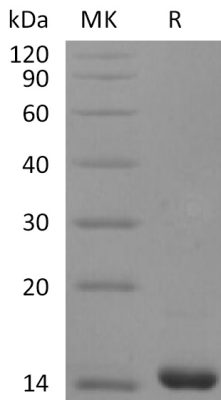| TARGET | |
|---|---|
| SYNONYMS |
Fibroblast growth factor 4;FGF-4;Heparin secretory-transforming protein 1;HST;HST-1;HSTF-1;Heparin-binding growth factor 4;HBGF-4;Transforming protein KS3;FGF4;HST;HSTF1;KS3 |
| DESCRIPTION |
Recombinant Human Fibroblast Growth Factor 4 is produced by our E.coli expression system and the target gene encoding Ser71-Leu206 is expressed. |
| DELIVERY |
In Stock |
| UNIPROT ID |
P08620 |
| EXPRESSION HOST |
E.coli |
| TAG | |
| MOLECULAR CHARACTERIZATION |
Not available |
| MOLECULAR WEIGHT |
15.1 KDa |
| PURITY |
Greater than 95% as determined by reducing SDS-PAGE. |
| FORMULATION & RECONSTITUTION |
Lyophilized from a 0.2 μm filtered solution of PBS, 5% Trehalose, pH 7.4. |
| STORAGE & SHIPPING |
Store at -20°C to -80°C for 12 months in lyophilized form. After reconstitution, if not intended for use within a month, aliquot and store at -80°C (Avoid repeated freezing and thawing). Lyophilized proteins are shipped at ambient temperature. |
| BACKGROUND |
Fibroblast growth factor 4(FGF-4) is a heparin binding member of the FGF family. The human FGF4 cDNA encodes 206 amino acids (aa) with a 33 aa signal sequence and a 173 aa mature protein with an FGF homology domain that contains a heparin binding region near the C-terminus. Mature human FGF4 shares 91%, 82%, 94% and 91% aa identity with mouse, rat, canine and bovine FGF4, respectively. Human FGF-4 has been shown to exhibit cross species activity. Expression of FGF-4 and its receptors, FGF R1c, 2c, 3c and 4, is spatially and temporally regulated during embryonic development. FGF-4 is proposed to play a physiologically relevant role in human embryonic stem cell selfrenewal. It promotes stem cell proliferation, but may also aid differentiation depending on context and concentration, and is often included in embryonic stem cell media in vitro. FGF-4 is mitogenic for fibroblasts and endothelial cells in vitro and has autocrine transforming potential. It is a potent angiogenesis promoter in vivo and has been investigated as therapy for coronary artery disease. |
| USAGE |
Research use only |
1
/
의
1
Dima Biotech
SKU(재고 관리 코드):PME30046
Human FGF-4 (136AA) Protein
Human FGF-4 (136AA) Protein
PRODUCT DATA
IMAGES

Figure 1. Greater than 95% as determined by reducing SDS-PAGE.
Share


